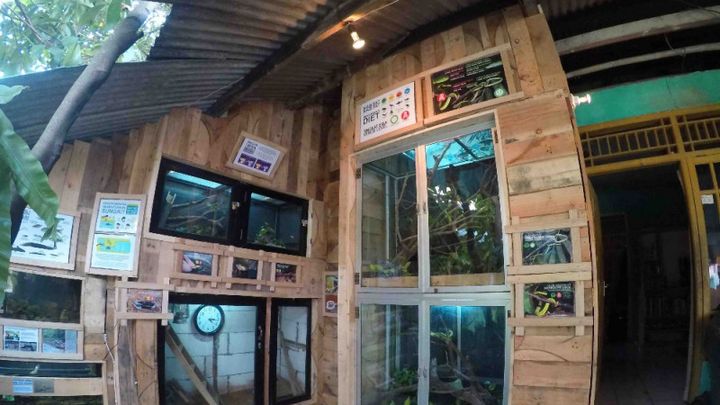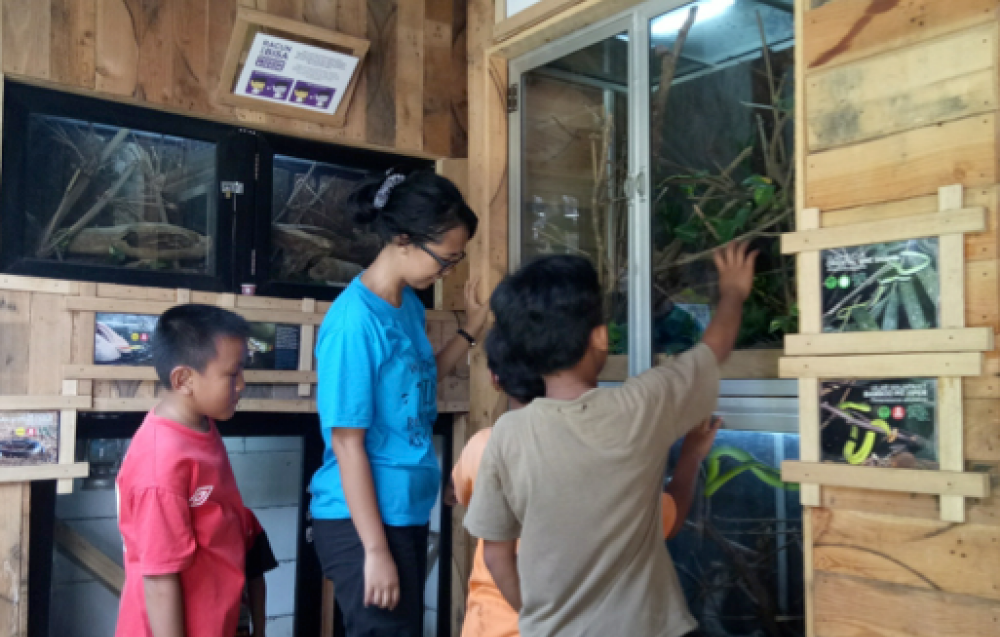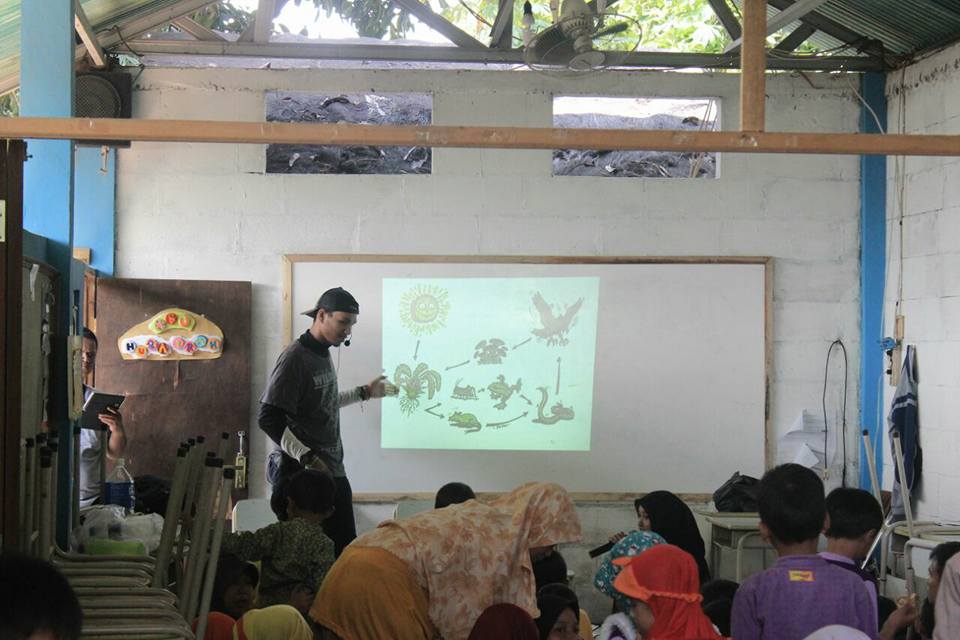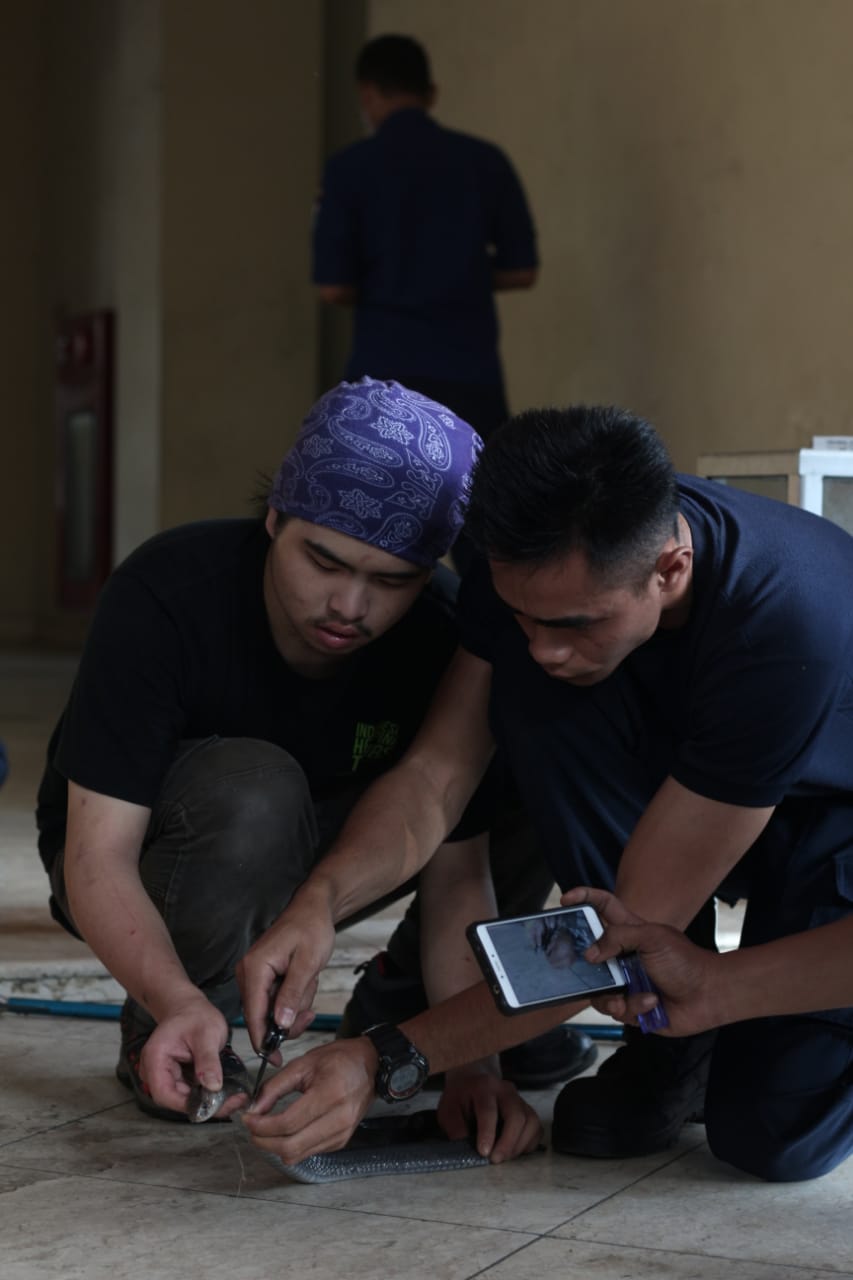
Ciliwung Herpetarium
About the Ciliwung Herpetarium
We are a small volunteer-based group located in Bojonggede, Bogor, West Java, Indonesia. 
Our programs are mainly focusing on research and education, as well as assisting to resolve human-animal conflict.
We run a small herpetarium (Ciliwung Herpetarium, previously known as the Ciliwung Reptile Center), mainly to serve as an educational facility for the public. In 2015, local villagers Mrs. Canih and Mr. Iwan, from Gelonggong Village offered their house to be used as our "basecamp" to run our conservation projects.
At the moment, the herpetarium is still based in this house. We do not charge admission to enter.

Since 2018, we have rented 2 rooms; one to serve as an off-show and quarantine area, and the other as a volunteer house.
Apart from being an educational facility, the herpetarium also serves as a laboratory to conduct studies on animal ecology and behaviour, which cannot be done in the wild. It also serves as a temporary holding space for animals which have been rescued from conflict with humans (e.g. a snake which has been removed from someone's kitchen) before being released.
Animal Welfare and Management: The welfare of the animals in captivity at our facility is a top priority, and we strive to provide the best that we can for them. The display enclosures are of appropriate size for the species they hold, as well as containing enrichment and facilities for the animals to move around and exhibit natural behaviours, such as hiding, climbing, foraging, basking, etc.
Mrs. Canih is always on standby to care for the animals, and we also have volunteers who are scheduled to come on certain days each week to maintain the animals. We have a record-keeping system for each individual in quarantine and on display. For animals which are kept in groups, we keep records for the group. When required, we have a volunteer veterinarian who helps with medical treatment of the animals.
Education: The herpetarium aims to educate visitors on conservation, especially regarding herpetofauna. Each live animal on display at the herpetarium tells a story and has an educational value. The educational value of the herpetarium was carefully planned and is currently undergoing improvements. 
In order to convey information and conservation messages to the general public, we try to make our signage easily understood for the public. Essentially this means that anyone from all ages and backgrounds will be able to understand what we are trying to say. To do this, we have as little text as possible, and a lot of pictures and cartoons which tell a story. At the moment, we are working on creating interactive signage, to make learning about animals and conservation more interesting and fun.
Aside from the herpetarium as an educational facility, starting 2019 we hope to conduct a year-long educational programme to educate the children in Gelonggong Village about nature conservation. The module and methods are currently being planned by our education team. 
Whenever possible, we will organize workshops and events for conservationists/biologists in Indonesia, in order to increase their skill, knowledge and network, especially regarding herpetology and conservation.
As we have always done, we will continue to conduct educational talks and presentations in schools, villages, and other public communities, to educate people about conservation.
In-situ Research: By 2019, we hope to have started several studies regarding herpetofauna in the wild, specifically in West Java. The results of these studies will hopefully contribute positively to conservation.
Two of the main projects will be an inventory of herpetofauna along the Ciliwung River, as well as studies on ecology and population of the Asian Narrow-Headed Softshell Turtle (Chitra chitra javanensis). This is extremely important as there is very little information on the ecology of this species, which is endemic and critically endangered.
Ex-Situ Research: Our main goal for 2019 is to create husbandry guidelines on several Javan amphibian species in captivity, at the same time conducting studies on behaviour and larval stages. 
Human-Animal Conflict Management: During our education and outreach programs, we advise on what to do when people encounter a snake. Should they find one in their house, they are able to call us and we will remove it for them whenever possible. The snakes will then be held in quarantine before being released into suitable habitat after habitat assessments and health check.

At the moment, we are unable to rehabilitate and monitor the animals after release, however we plan to do so in the future if it is possible. We have planned a collaboration with Halimun Salak National Park in West Java to potentially rehabilitate and release animals within the National Park.
Funding: As we are a volunteer-based group, we rely mainly on donations for funding. We also run herping tours to raise funds for our projects.
Thanks to all the donations received, we were able to renovate the herpetarium in 2017, and keep it running until now.
We are currently undergoing another renovation to improve the animal welfare and educational value of the herpetarium. However, we are very low on funds to continue the renovation and keep our projects running until the end of 2018. 
The image below is a floor plan for the herpetarium.
Ciliwung River Biotope: The first thing upon arrival will be an interactive retractable banner, which visitors must pull in order to see the banner. This banner will introduce the Ciliwung River Ecosystem and its importance, presented in an attractive, simple manner.
The biotope itself will be a large aquarium replicating a clean, unpolluted river, filled with several species of native fish from the Ciliwung River. This will show visitors the diversity of animals in the river, using freshwater fish as an example.
As they enter, they will see a large poster on the wall, which explains the importance of biodiversity.
Amphibian Paludarium: The next thing they see will be a beautifully planted paludarium housing Javan chorus frogs and Trilaksono's bush frogs. This is still related to biodiversity, as it shows the recently discovered bush frog, and also both species of frogs are endemic to Java. Above the paludarium there will be a series of photographs of different amphibians on Java, many of which are endemic.
As they move on, they will see a large poster on the wall which explains why herpetofauna are important, both in the ecosystem and also for humans.
Green Snakes: Before they see the snakes, visitors will first be presented with a wall filled with interactive flip signs, where "true or false" questions will be on the first page (e.g. are snakes afraid of salt?), and they must flip the page in order to see the answer and explanation. Again, this will be presented in the most simple way possible, with minimal text and easily understood cartoons. The questions on these signs will be common myths and/or misunderstandings which most people believe in West Java.
Moving forward, there will be two vivariums filled with green snakes commonly found in West Java. The first one contains a harmless vine snake, while the second one houses a highly venomous green viper. Most people believe that all green snakes are lethal, especially those with a triangular head. This exhibit will bust that myth and explain the differences between the two species.
Poison and Venom: The next exhibit will comprise of three enclosures, representing venomous and poisonous animals. Above the enclosures, there will be a large sign explaining the difference between poison and venom using cartoons and minimal text. A large enclosure filled with a broom, bucket, ladder, clock and other man-made objects will house spitting cobras, showing that these snakes are often found in or near human surroundings. There will be a comic strip explaining why. The cobras represent venomous animals. On top of the cobras, there will be two vivariums next to each other. One contains the river toad (poisonous), while the other contains the red necked keelback (poisonous and venomous). Here we will explain also the interaction between the keelback and the toad, as it feeds on toads and sequesters the poison.
To the right of this exhibit there will be a wall discussing snakebite. It will show using cartoons and pictures how to mitigate snakebite, myths about snakebite treatment and the correct first aid for venomous snakebites. We will have a transparant case displaying specimens of three species for which antivenom is available, while doing so explaining the antivenom crisis in Indonesia.
Humans and Nature: The next thing they will see is a corner with interactive displays, a vertical garden, and rubbish running along the walls. The wall on the right will have a large poster showing the water cycle and why humans need the river. It will also contain an interactive display with two tanks, where visitors can pour water into them. Both will contain miniature houses in them and a false bottom in order to see the water. The first one will be using natural substrate and the second will have garbage. This aims to illustrate how garbage pollution affects people (flooding).
The middle wall will have a large poster showing the destruction of nature and what we can do to help (e.g. use less plastic). Here there will be an interactive box with pictures on the side. On top of the box, there will be several items such as bottles and cans. When the items are pressed, the pictures on the side of the box will change (For instance, there is a picture of a healthy bird on the riverbank. When you press the bottle, the picture will change to a picture of a dead bird with its head stuck in a bottle). This aims to illustrate the destruction of nature caused by humans.
The left wall, dividing this section from the turtle pond, is formed of an aquarium, which will have garbage surrounding it and going inside it. This aquarium will be filled with invasive species of fish.
Turtle Pond: Next to the invasive fish aquarium, there will be a collection of preserved specimens of invasive species from other taxa. This will explain about invasive species and how they are harmful to the environment. Below the aquarium and specimen display, there will be a glass panel, where visitors can view the turtles using their land area. This will be fitted with artificial UV lighting, as there is not enough UV from natural sunlight due to a shady tree in the enclosure and a roof covering it partially.
The turtles on display are black marsh turtles, a native species with slow reproduction, therefore prone to being outcompeted by invasive species such as the red eared slider. Here we will have another interactive retractable banner, which visitors must pull. This banner will use cartoons to tell the story of how the red eared slider got in our ecosystems, how it is causing damage, and also promote responsible pet ownership.
Any donation, no matter how small, will be much appreciated.
For more information and updates, please visit:
www.facebook.com/ciliwungherpetarium
www.instagram.com/ciliwungherpetarium